Reading time for children: 14 min
Hard by a great forest dwelt a wood-cutter with his wife, who had an only child, a little girl of three years old. They were, however, so poor that they no longer had daily bread, and did not know how to get food for her. One morning the wood-cutter went out sorrowfully to his work in the forest, and while he was cutting wood, suddenly there stood before him a tall and beautiful woman with a crown of shining stars on her head, who said to him, „I am the Virgin Mary, mother of the child Jesus. Thou art poor and needy, bring thy child to me, I will take her with me and be her mother, and care for her.“ The wood-cutter obeyed, brought his child, and gave her to the Virgin Mary, who took her up to heaven with her.
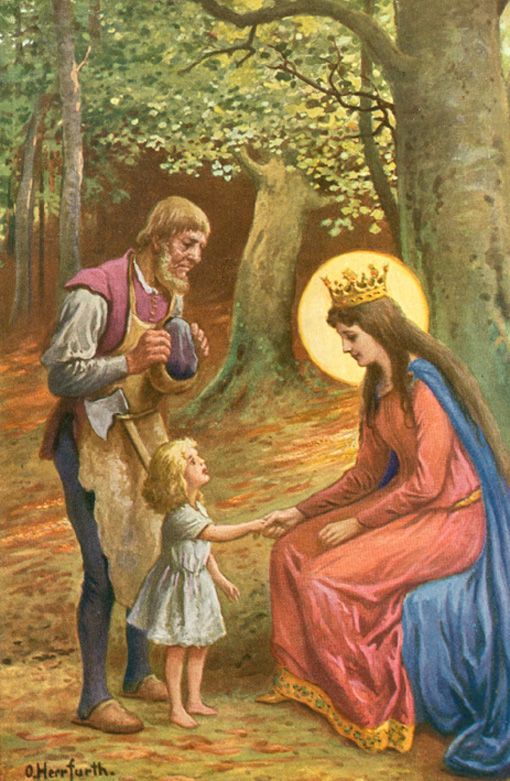 Image: Oskar Herrfurth (1862-1934)
Image: Oskar Herrfurth (1862-1934)There the child fared well, ate sugar-cakes, and drank sweet milk, and her clothes were of gold, and the little angels played with her. And when she was fourteen years of age, the Virgin Mary called her one day and said, „Dear child, I am about to make a long journey, so take into thy keeping the keys of the thirteen doors of heaven. Twelve of these thou mayest open, and behold the glory which is within them, but the thirteenth, to which this little key belongs, is forbidden thee. Beware of opening it, or thou wilt bring misery on thyself.“
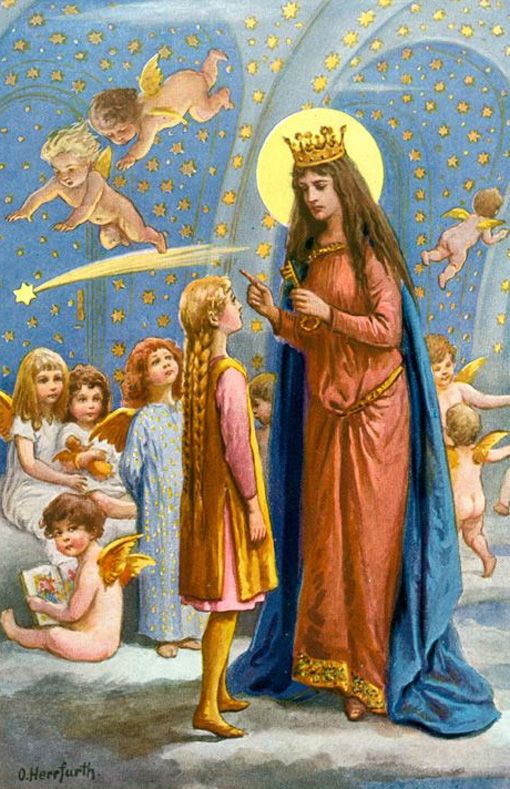 Image: Oskar Herrfurth (1862-1934)
Image: Oskar Herrfurth (1862-1934)The girl promised to be obedient, and when the Virgin Mary was gone, she began to examine the dwellings of the kingdom of heaven. Each day she opened one of them, until she had made the round of the twelve. In each of them sat one of the Apostles in the midst of a great light, and she rejoiced in all the magnificence and splendour, and the little angels who always accompanied her rejoiced with her. Then the forbidden door alone remained, and she felt a great desire to know what could be hidden behind it, and said to the angels, „I will not quite open it, and I will not go inside it, but I will unlock it so that we can just see a little through the opening.“
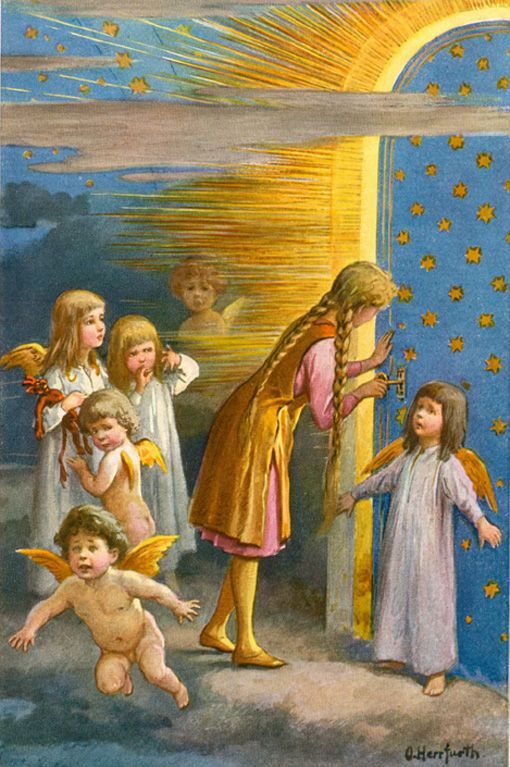 Image: Oskar Herrfurth (1862-1934)
Image: Oskar Herrfurth (1862-1934)„Oh no,“ said the little angels, „that would be a sin. The Virgin Mary has forbidden it, and it might easily cause thy unhappiness.“ Then she was silent, but the desire in her heart was not stilled, but gnawed there and tormented her, and let her have no rest. And once when the angels had all gone out, she thought, „Now I am quite alone, and I could peep in. If I do it, no one will ever know.“ She sought out the key, and when she had got it in her hand, she put it in the lock, and when she had put it in, she turned it round as well. Then the door sprang open, and she saw there the Trinity sitting in fire and splendour.
She stayed there awhile, and looked at everything in amazement. Then she touched the light a little with her finger, and her finger became quite golden. Immediately a great fear fell on her. She shut the door violently, and ran away. Her terror too would not quit her, let her do what she might, and her heart beat continually and would not be still. The gold too stayed on her finger, and would not go away, let her rub it and wash it never so much. It was not long before the Virgin Mary came back from her journey. She called the girl before her, and asked to have the keys of heaven back. When the maiden gave her the bunch, the Virgin looked into her eyes and said, „Hast thou not opened the thirteenth door also?“ „No,“ she replied.
Then she laid her hand on the girl’s heart, and felt how it beat and beat, and saw right well that she had disobeyed her order and had opened the door. Then she said once again, „Art thou certain that thou hast not done it?“ „Yes,“ said the girl, for the second time. Then she perceived the finger which had become golden from touching the fire of heaven, and saw well that the child had sinned, and said for the third time, „Hast thou not done it?“ „No,“ said the girl for the third time. Then said the Virgin Mary, „Thou hast not obeyed me, and besides that thou hast lied, thou art no longer worthy to be in heaven.“
Then the girl fell into a deep sleep, and when she awoke she lay on the earth below, and in the midst of a wilderness. She wanted to cry out, but she could bring forth no sound. She sprang up and wanted to run away, but whithersoever she turned herself, she was continually held back by thick hedges of thorns through which she could not break. In the desert, in which she was imprisoned, there stood an old hollow tree, and this had to be her dwelling-place. Into this she crept when night came, and here she slept. Here, too, she found a shelter from storm and rain, but it was a miserable life, and bitterly did she weep when she remembered how happy she had been in heaven, and how the angels had played with her.
Roots and wild berries were her only food, and for these she sought as far as she could go. In the autumn she picked up the fallen nuts and leaves, and carried them into the hole. The nuts were her food in winter, and when snow and ice came, she crept amongst the leaves like a poor little animal that she might not freeze. Before long her clothes were all torn, and one bit of them after another fell off her. As soon, however, as the sun shone warm again, she went out and sat in front of the tree, and her long hair covered her on all sides like a mantle. Thus she sat year after year, and felt the pain and the misery of the world.
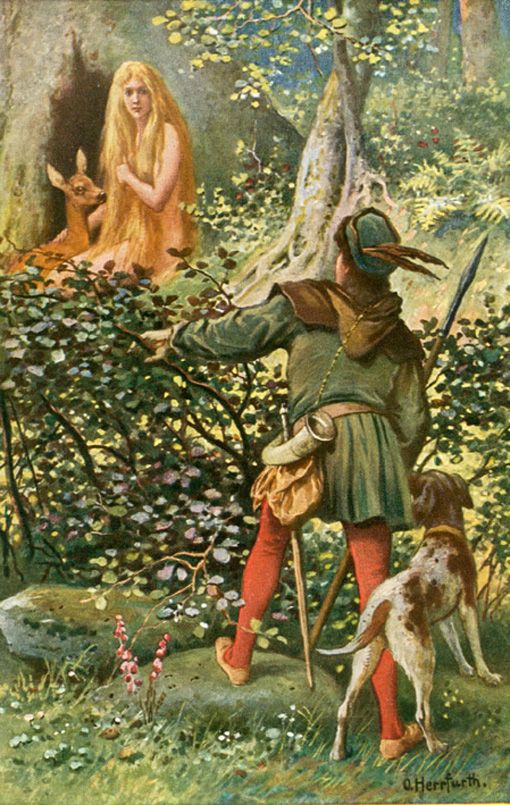 Image: Oskar Herrfurth (1862-1934)
Image: Oskar Herrfurth (1862-1934)One day, when the trees were once more clothed in fresh green, the King of the country was hunting in the forest, and followed a roe, and as it had fled into the thicket which shut in this bit of the forest, he got off his horse, tore the bushes asunder, and cut himself a path with his sword. When he had at last forced his way through, he saw a wonderfully beautiful maiden sitting under the tree. And she sat there and was entirely covered with her golden hair down to her very feet. He stood still and looked at her full of surprise, then he spoke to her and said, „Who art thou? Why art thou sitting here in the wilderness?“ But she gave no answer, for she could not open her mouth. The King continued, „Wilt thou go with me to my castle?“ Then she just nodded her head a little. The King took her in his arms, carried her to his horse, and rode home with her, and when he reached the royal castle he caused her to be dressed in beautiful garments, and gave her all things in abundance.
Although she could not speak, she was still so beautiful and charming that he began to love her with all his heart, and it was not long before he married her. After a year or so had passed, the Queen brought a son into the world. Thereupon the Virgin Mary appeared to her in the night when she lay in her bed alone, and said, „If thou wilt tell the truth and confess that thou didst unlock the forbidden door, I will open thy mouth and give thee back thy speech, but if thou perseverest in thy sin, and deniest obstinately, I will take thy new-born child away with me.“ Then the queen was permitted to answer, but she remained hard, and said, „No, I did not open the forbidden door“, and the Virgin Mary took the new-born child from her arms, and vanished with it. Next morning, when the child was not to be found, it was whispered among the people that the Queen was a man-eater, and had killed her own child. She heard all this and could say nothing to the contrary, but the King would not believe it, for he loved her so much.
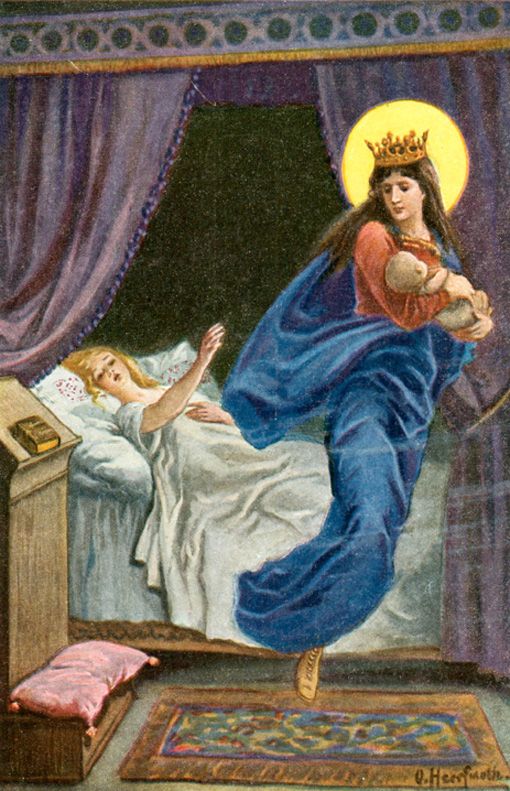 Image: Oskar Herrfurth (1862-1934)
Image: Oskar Herrfurth (1862-1934)When a year had gone by the Queen again bore a son, and in the night the Virgin Mary again came to her, and said, „If thou wilt confess that thou openedst the forbidden door, I will give thee thy child back and untie thy tongue. But if you continuest in sin and deniest it, I will take away with me this new child also.“ Then the Queen again said, „No, I did not open the forbidden door;“ and the Virgin took the child out of her arms, and away with her to heaven. Next morning, when this child also had disappeared, the people declared quite loudly that the Queen had devoured it, and the King’s councillors demanded that she should be brought to justice. The King, however, loved her so dearly that he would not believe it, and commanded the councillors under pain of death not to say any more about it. The following year the Queen gave birth to a beautiful little daughter, and for the third time the Virgin Mary appeared to her in the night and said, „Follow me.“
She took the Queen by the hand and led her to heaven, and showed her there her two eldest children, who smiled at her, and were playing with the ball of the world. When the Queen rejoiced thereat, the Virgin Mary said, „Is thy heart not yet softened? If thou wilt own that thou openedst the forbidden door, I will give thee back thy two little sons.“ But for the third time the Queen answered, „No, I did not open the forbidden door.“ Then the Virgin let her sink down to earth once more, and took from her likewise her third child. Next morning, when the loss was reported abroad, all the people cried loudly, „The Queen is a man-eater! She must be judged,“ and the King was no longer able to restrain his councillors. Thereupon a trial was held, and as she could not answer, and defend herself, she was condemned to be burnt alive.
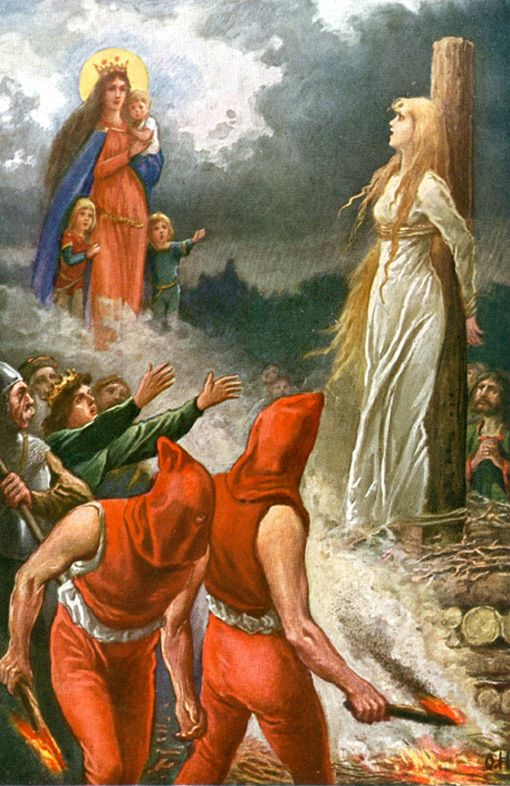 Image: Oskar Herrfurth (1862-1934)
Image: Oskar Herrfurth (1862-1934)The wood was got together, and when she was fast bound to the stake, and the fire began to burn round about her, the hard ice of pride melted, her heart was moved by repentance, and she thought, „If I could but confess before my death that I opened the door.“ Then her voice came back to her, and she cried out loudly, „Yes, Mary, I did it;“ and straightway rain fell from the sky and extinguished the flames of fire, and a light broke forth above her, and the Virgin Mary descended with the two little sons by her side, and the new-born daughter in her arms. She spoke kindly to her, and said, „He who repents his sin and acknowledges it, is forgiven.“ Then she gave her the three children, untied her tongue, and granted her happiness for her whole life.
 Learn languages. Double-tap on a word.Learn languages in context with Childstories.org and Deepl.com.
Learn languages. Double-tap on a word.Learn languages in context with Childstories.org and Deepl.com.Backgrounds
Interpretations
Adaptions
Summary
Abstract
Linguistics
„Mary’s Child“ (also known as „Our Lady’s Child“ or „Marienkind“) is a fairy tale collected and recorded by the Brothers Grimm, appearing in their famous collection, „Grimms‘ Fairy Tales“, first published in 1812. The story, like many other tales recorded by the Brothers Grimm, has its origins in European folklore and oral storytelling traditions. The tale has been passed down through generations before being documented and published in the early 19th century.
The story is about a poor woodcutter and his wife who are childless and wish for a child. One day, they are visited by the Virgin Mary, who grants their wish and gives them a daughter. As the child grows, she becomes very beautiful and pious. When she turns fourteen, the Virgin Mary takes her to heaven to live with her for three years. Mary gives the girl a set of keys to the thirteen doors of the heavenly kingdom and instructs her not to open the thirteenth door. However, the girl’s curiosity gets the better of her, and she disobeys Mary’s warning, which results in dire consequences.
The story’s background is rooted in European folklore and Christian tradition. It shares themes and motifs with other fairy tales, such as the importance of obedience, the dangers of curiosity, and the consequences of breaking a promise. Additionally, the story incorporates religious elements, as the Virgin Mary plays a significant role in the narrative, highlighting the influence of Christianity on European folklore at the time. The Brothers Grimm were German academics, linguists, and folklorists who collected and published numerous fairy tales, many of which have become classics. They aimed to preserve traditional stories that were passed down orally through generations, and their work has had a lasting impact on the study of folklore and the popularity of fairy tales.
„Mary’s Child“ centers around the theme of Christian faith and explores the consequences of disobedience, curiosity, and redemption. The tale tells the story of a poor woodcutter and his wife, who are granted a child by the Virgin Mary. In exchange, the couple promises to raise their daughter with love and devotion. When the girl turns fourteen, the Virgin Mary takes her to heaven to serve as her personal attendant.
In the heavenly realm, the girl is given access to thirteen doors, twelve of which she is allowed to enter. The thirteenth door, however, is forbidden. Driven by curiosity, the girl disobeys the Virgin Mary and opens the forbidden door, discovering a vision of the Holy Trinity. As a consequence, she loses her ability to speak and is cast out of heaven, left to wander the earth in search of redemption. The backgrounds to „Mary’s Child“ reflect the Brothers Grimm’s efforts to preserve traditional European folktales and oral storytelling traditions. The tale also demonstrates the influence of Christian themes and morality, which are prevalent in many of the Grimms‘ stories.
„Mary’s Child“ from the Brothers Grimm presents various interpretations and themes that can be explored. Some of the key interpretations of the story include.
The importance of obedience: The Virgin Mary gives the girl a specific instruction not to open the forbidden door. However, the girl disobeys and opens the door, leading to severe consequences. The story underscores the importance of obeying rules and respecting authority. The girl’s curiosity ultimately leads to her downfall. While curiosity is often regarded as a positive trait, this story serves as a reminder that excessive or uncontrolled curiosity can lead to negative outcomes.
The consequences of disobedience and curiosity: The girl’s decision to open the forbidden door despite the Virgin Mary’s warning illustrates the theme of disobedience and curiosity. Her actions lead to her punishment and expulsion from heaven, demonstrating the consequences of not following instructions and succumbing to curiosity. The queen’s refusal to admit her disobedience results in her losing her children and being accused of terrible crimes. It is only when she humbles herself and confesses her sin that she is saved. The story demonstrates the negative consequences of pride and deceit and the importance of honesty and humility.
The importance of faith and redemption: Throughout the story, the central character’s faith in the Virgin Mary and her desire for redemption play a significant role in her journey. Despite her mistakes, she remains devoted to her faith, ultimately finding redemption through her perseverance. The queen undergoes a significant transformation throughout the story, from living in heavenly bliss to experiencing the pain and misery of the world. Through her suffering, she learns the importance of humility, repentance, and forgiveness, ultimately leading to her redemption.
The power of forgiveness and mercy: The story emphasizes the concept of forgiveness and mercy, as the girl is eventually granted redemption and regains her ability to speak. This illustrates the Christian belief in the power of forgiveness and the importance of seeking redemption for one’s sins. The queen’s repentance at the end of the story leads to her redemption. The Virgin Mary forgives her, showing that repentance and acknowledgment of one’s mistakes can lead to forgiveness and a second chance.
The role of fate and destiny: The girl’s life is marked by extraordinary events, from her miraculous birth to her service in heaven and her eventual redemption. The story can be interpreted as an exploration of the role of fate and destiny in one’s life, as well as the idea that a higher power guides individuals through their experiences.
The influence of Christian morality: „Mary’s Child“ showcases Christian themes and morality throughout the narrative. The presence of the Virgin Mary and the Holy Trinity, as well as the emphasis on faith, forgiveness, and redemption, reflect the influence of Christian beliefs and values in the story.
Overall, „Mary’s Child“ presents various themes and interpretations that explore disobedience, curiosity, faith, redemption, forgiveness, and the influence of Christian morality. The story serves as a cautionary tale, reminding readers of the importance of following instructions and the consequences of succumbing to curiosity. At the same time, it highlights the power of faith and redemption, demonstrating that forgiveness and mercy can lead to personal growth and spiritual renewal.
„Mary’s Child“ is a German fairy tale collected by the Brothers Grimm in their famous collection, „Grimms‘ Fairy Tales,“ which was first published in 1812. The Brothers Grimm, Jacob and Wilhelm Grimm, were German academics and linguists who dedicated their lives to collecting and documenting the folktales of their time. Their collection of stories has become one of the most well-known and widely read collections of fairy tales in the world. While „Mary’s Child“ may not be as well-known as some other fairy tales collected by the Brothers Grimm, there have been adaptations of the story in various formats, including:
Children’s Books: Illustrated children’s books have adapted „Mary’s Child“ as standalone stories or as part of collections featuring other Brothers Grimm tales. These adaptations often simplify the language and use engaging illustrations to make the story more accessible to younger readers. „Our Lady’s Child“ (2021): This children’s book by author Jane Yolen and illustrator Linda Graves is a retelling of the fairy tale. The book follows a poor couple who make a promise to dedicate their child to the Virgin Mary. When the child is cursed by a beggar woman, the couple seeks the Pope’s blessing to break the curse.
Theater Productions: Stage adaptations of „Mary’s Child“ have been presented as live theater performances, often as part of larger productions featuring a series of Grimm fairy tales. These adaptations may include original music, creative set designs, and innovative interpretations of the source material. „Our Lady’s Child“ (2016): This opera by composer Anthony Vine is based on the Brothers Grimm fairy tale. The opera explores themes of sacrifice, devotion, and the power of blessings. It premiered at the Experimental Media and Performing Arts Center in New York.
Animated Films and TV Series: Animated adaptations of the Brothers Grimm’s stories may include episodes or segments that feature „Mary’s Child.“ These adaptations often modernize the source material and make it more engaging for contemporary audiences while preserving the central themes and moral lessons. „The Bells of Notre Dame“ (1996): This Disney animated film is loosely based on the story of „Our Lady’s Child.“ The character Quasimodo is abandoned as a baby and taken in by the archdeacon of Notre Dame, who promises to protect him. However, Quasimodo’s life is threatened by the villainous Frollo, who wants to eliminate him. In the end, Quasimodo’s devotion to the Virgin Mary saves him and he becomes a hero. „Our Lady’s Child“ (2008): This short film by director Daniel C. Nyiri is a modern retelling of the fairy tale set in Hungary. The story follows a young couple who pray for a child and make a promise to dedicate him to the Virgin Mary. However, the child is cursed by a beggar woman and the couple sets out on a pilgrimage to seek the Pope’s blessing.
Audiobooks: The story has been adapted into audiobooks or audio dramas, with voice actors and sound effects bringing the tale to life in an audio-only format. These adaptations allow listeners to use their imagination to visualize the events of the story while enjoying the audio performances.
Artwork and Illustrations: Artists and illustrators have created visual interpretations of „Mary’s Child,“ often focusing on key scenes or characters from the story. These artworks can be found in galleries, online, or as part of illustrated book editions.
The fairy tale „Our Lady’s Child“ (also known as „The Virgin Mary’s Child“) has been adapted and retold in various forms over the years. Although „Mary’s Child“ may not have as many high-profile adaptations as some other Grimm fairy tales, its themes and moral lessons continue to resonate with audiences, inspiring various adaptations and retellings that introduce the tale to new generations.
„Mary’s Child“ is a fairy tale collected by the Brothers Grimm that tells the story of a poor woodcutter and his wife who are granted a child by the Virgin Mary. In exchange for this blessing, the couple promises to raise their daughter with love and devotion. When the girl turns fourteen, the Virgin Mary takes her to heaven to serve as her personal attendant.
In heaven, the girl is given access to thirteen doors. She is allowed to enter twelve of them but is strictly forbidden to open the thirteenth door. Overcome by curiosity, the girl disobeys the Virgin Mary and opens the forbidden door, where she glimpses the Holy Trinity. As a punishment for her disobedience, the girl loses her ability to speak and is cast out of heaven.
The girl wanders the earth, enduring various hardships and seeking redemption for her actions. Eventually, she comes across a king who, intrigued by her beauty and silence, marries her. The couple has three children, but each time a child is born, the Virgin Mary appears to the king and claims the child as her own, stating that the mother must confess her sins to have them returned.
Falsely accused of cannibalism, the queen is sentenced to death. Just before her execution, the Virgin Mary appears, and the girl finally confesses her disobedience in heaven. The Virgin Mary forgives her and restores her ability to speak. The children are returned, and the girl’s innocence is proven. The family is reunited, and they live happily ever after, grateful for the mercy and forgiveness they received.
„Mary’s Child“ is a fairy tale by Brothers Grimm that tells the story of a poor woodcutter and his wife who entrust their only child to the Virgin Mary due to their poverty. The Virgin Mary takes the child to heaven, where she grows up happily, playing with angels. When she turns fourteen, the Virgin Mary gives her the keys to thirteen doors in heaven and warns her not to open the forbidden thirteenth door. The girl, unable to resist her curiosity, eventually opens the door and sees the Holy Trinity. As a result, she is cast out of heaven and loses her ability to speak.
The girl lives a miserable life in a forest until a king finds her and takes her to his castle. They marry and have children, but each time the Virgin Mary appears, offering to restore her speech if she confesses her disobedience. The queen refuses to confess and, as a consequence, loses her children. Accused of being a man-eater, she is eventually sentenced to death. Bound to a stake and surrounded by flames, the queen finally repents and confesses her sin. Miraculously, the rain extinguishes the fire, and the Virgin Mary appears with the queen’s children. She forgives the queen, restores her speech, and grants her happiness for the rest of her life.
„Mary’s Child“ is a story that combines elements of religious folklore and traditional fairy tales. It centers around a young girl who is taken to heaven by the Virgin Mary and later faces trials and tribulations due to her disobedience and curiosity. The tale explores themes of obedience, curiosity, pride, deceit, repentance, and forgiveness. As a fairy tale, „Mary’s Child“ belongs to a rich tradition of oral storytelling in European culture. Fairy tales often served as cautionary tales or moral lessons for children, using fantastical elements and engaging narratives to convey important values and life lessons. The Brothers Grimm aimed to preserve these stories by collecting them from various sources, including oral accounts and written texts, and publishing them in their collection. Over time, the Brothers Grimm’s collection has become an influential part of Western culture, inspiring numerous adaptations, including plays, films, and other literary works. „Mary’s Child,“ although not as well-known as some other Grimm tales such as „Cinderella“ or „Snow White,“ remains an important part of this rich storytelling tradition.
The fairy tale „Mary’s Child“ by the Brothers Grimm is a rich text for linguistic analysis, highlighting various elements such as narrative structure, character development, theme, and language use.
Here’s an analysis of these aspects:
Narrative Structure
Introduction and Exposition: The narrative begins by setting the scene of a poor wood-cutter family living near a great forest. The introduction of the Virgin Mary as a deus ex machina offering salvation for the wood-cutter’s child sets the tale into motion.
Rising Action: The girl is taken to heaven, where she lives in splendor and is given a task by the Virgin Mary. The episodic exploration of the doors of heaven builds suspense, especially regarding the forbidden thirteenth door.
Climax: The pivotal moment occurs when the girl opens the forbidden door, disobeying Mary’s command. This act of transgression drives the rest of the story’s events and consequences.
Falling Action: Following her disobedience, the girl is cast out of heaven. Her subsequent silent suffering and the loss of her children continue until her eventual trial.
Resolution: The story resolves when the Virgin Mary provides an opportunity for confession and redemption, culminating in the queen’s repentance and restoration of her children and speech.
Character Development
The Maiden: The protagonist begins as an innocent child, transitions into a curious adolescent, and then into a repentant adult. Her journey explores themes of curiosity, disobedience, guilt, and ultimately redemption.
Virgin Mary: She serves dual roles as both a nurturing figure and a moral arbiter. Mary’s tests and punishments are pivotal to the maiden’s development and the narrative’s moral framework.
The King: Although a relatively minor character, he symbolizes earthly love and loyalty, providing a counterbalance to the maiden’s divine interactions.
Themes
Obedience and Disobedience: Central to the story is the theme of obedience to divine authority, represented by the Virgin Mary’s command.
Curiosity: The tale suggests both the dangers of unchecked curiosity and its inevitability in the human experience.
Sin and Redemption: It explores the nature of sin and the power of repentance and forgiveness, illustrated through the maiden’s journey from fall to redemption.
Speech and Silence: The motif of speech, silence, and confession emphasizes the power of truth and acknowledgement in achieving grace and reconciliation.
Language and Style
Symbolism: The story employs rich symbolism, such as the shining crown of stars (divine authority and purity), the forbidden door (temptation and knowledge), and the golden finger (mark of transgression).
Repetition: The narrative uses repetition to emphasize moral lessons and thematic elements, particularly in the maiden’s denial and eventual confession.
Imagery: Vivid descriptions create a stark contrast between the opulence of heaven and the desolation of the earthly wilderness, emphasizing the consequences of the maiden’s actions.
Moralistic Tone: The story’s language reinforces its moral lessons, consistent with many of the Brothers Grimm tales, which often served to impart ethical teachings.
In summary, „Mary’s Child“ operates on multiple levels, intertwining traditional fairy tale elements with a moral narrative that explores human frailty and divine mercy. The linguistic elements serve not only to advance the plot but also to deepen the thematic resonance of the tale.
Information for scientific analysis
Fairy tale statistics | Value |
|---|---|
| Number | KHM 3 |
| Aarne-Thompson-Uther-Index | ATU Typ 710 |
| Translations | DE, EN, EL, DA, ES, FR, PT, FI, HU, IT, JA, NL, KO, PL, RU, TR, VI, ZH |
| Readability Index by Björnsson | 32.5 |
| Flesch-Reading-Ease Index | 76.9 |
| Flesch–Kincaid Grade-Level | 8.4 |
| Gunning Fog Index | 11.1 |
| Coleman–Liau Index | 7.7 |
| SMOG Index | 9.1 |
| Automated Readability Index | 9.2 |
| Character Count | 9.927 |
| Letter Count | 7.621 |
| Sentence Count | 81 |
| Word Count | 1.910 |
| Average Words per Sentence | 23,58 |
| Words with more than 6 letters | 170 |
| Percentage of long words | 8.9% |
| Number of Syllables | 2.394 |
| Average Syllables per Word | 1,25 |
| Words with three Syllables | 84 |
| Percentage Words with three Syllables | 4.4% |


















A thinly veiled coming-of-age / x-ual-awakening story. This story really paints the Virgin spirit of Mary (who incidentally, was no longer a ‚virgin‘ after bearing at least 7 children, no matter the ambitions of St Augustine and Pius IX) as an stubborn, spiteful, cursed temptress.